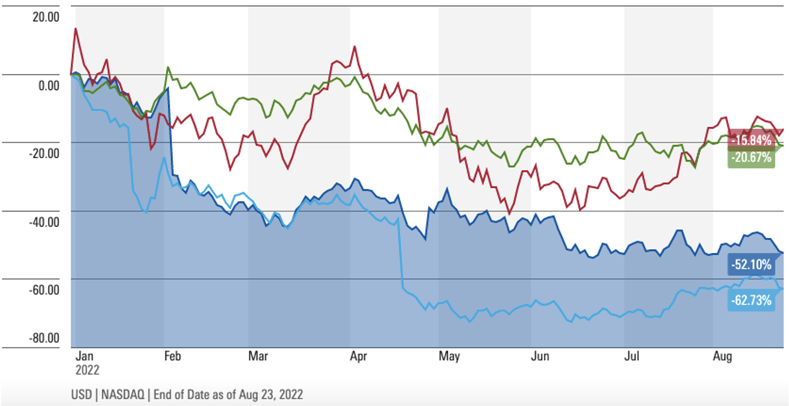Facebook, Tesla, Google and Netflix...I can hear what you're thinking. Record profits equal exciting prospects for investors. Think again.
If you wanted to buy a handful of stocks, which would you pick?
I’ve been asking people that question for more than 20 years. Most people say,
“Fast-growing businesses with exciting prospects.”
That makes sense.
But after a period of great returns, fast-growing businesses can become lousy stocks…sometimes for a decade.
I can hear what you’re thinking.
If a company continues to earn record business profits, that won’t happen.
First, let’s bust that crystal ball.
Nobody can forecast what businesses will keep earning record profits.
Second, even if we could see a business’ future, that isn’t the key to how its stock will perform.
This is why legendary money manager Kenneth Fisher calls the stock market, “The Great Humiliator”.
Fisher’s words might be painful or prophetic if you bought a popular tech stock last year.
For example, if you invested $10,000 in Facebook (Meta Platforms), Tesla, Google or Netflix on 1 January 2022, that money would have plunged to $4,720, $8,416, $7,934 and $3,727 respectively by 23 August.
Those are painful kicks to the crotch, despite those companies earning record business profits.
Below is a graph showing the stock performance YTD of the following businesses:
Facebook (Meta)
Tesla
Netflix
 Source: Monringstar.com
Source: Monringstar.com
Consider Netflix.
The company’s net business income almost doubled from 2020 to 2021.
And according to revenue generated during the first two quarters of 2022, Netflix is estimated to earn even higher profits in 2022.
Yet, from 1 January 2022 to 23 August 2022, Netflix’s stock dropped 62.73%.
Similar stories of record profitability can be told for Facebook (Meta), Tesla and Google.
But as shown above, their stocks sank too.
Here’s a chilly example of what could happen.
Intel Corp was one of the world’s most popular stocks in the late 1990s. From 1990-2000, a $10,000 investment in Intel would have grown to $284,414.
In 1999, I bought that stock, along (it seemed) with almost everybody else.
After the year 2000, Intel’s business profits continued to increase as home computers became as common as toasters.
Intel’s chips were in most PCs.
Those little chips were in Apple’s computers, too.
By 2004, Intel’s CEO, Craig R. Barrett reported:
“We ended 2004 with record revenues and robust demand for Intel architecture products…”
Sounds great, right?
Intel ended 2004 with record revenues.
But if you had invested $10,000 in Intel’s stock in January 2000, it would have sunk to $5,784 by 31 December 2004, with all dividends reinvested.
No, this wasn’t an aberration.
The same thing happened to most of the world’s fastest-growing (in terms of business earnings) blue-chip technology stocks.
They continued to earn record business profits.
But their stocks sank.
Below, you can see how the S&P 500 thumped the returns of Oracle, Cisco Systems and Microsoft from 2000-2014...
Despite those companies earning record business profits.
| Company | Net Income Growth 2000-2014 | A $10,000 investment would have turned into |
| Oracle | +74% | $16,977 |
| Cisco Systems | +101% | $5,688 |
| Microsoft | +134% | $11,080 |
| S&P 500 Index | $18,359 |
Source for stock returns including dividends: portfoliovisualizer.com
Source for net income: each company's respective annual report
Savvy stock buyers know that it takes more than rising business profits and an exciting story to make a stock keep rising.
Instead, there are three main influences:
- Rising business growth for the company
- Company growth that meets or exceeds analysts’ and investors’ expectations
- If the stock has been rising faster than the business’ earnings growth, a painful correction (or poor future performance) will eventually occur.
Cisco Systems, above, is a classic case of #2 and #3.
From 2000-2014, the company continued to earn record business profits.
But analysts and investors had expectations that the company couldn’t meet (#2).
And because, from 1990-2000, the stock had risen far faster than its business earnings (#3), the chickens eventually came home to roost.
That’s why Cisco Systems increased its net income by 101% from 2000-2014, while the stock’s 14-year return was -46%.
Let’s bring this back to today.
Most of the last decade’s feverishly popular technology companies also accompany sky-high expectations (#2).
What’s more, over the past decade, their stocks also rose far faster than their business earnings.
That doesn’t mean your favourite technology stocks will continue to sink or languish for a decade.
A couple of them might buck the trend.
But do you know which? Nobody does.
That’s why, instead, you should invest in a diversified portfolio of index funds.
If you’re going to hand-pick stocks that you think will do well, always remember…
The stock market really is The Great Humiliator.
Andrew Hallam is the best-selling author of Millionaire Expat (3rd edition), Balance, and Millionaire Teacher.

